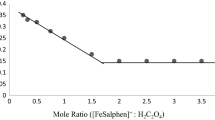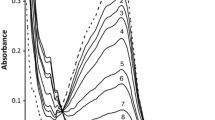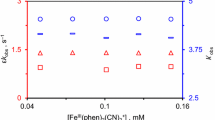Summary
The kinetics of outer-sphere oxidation of Fe(Xphen) 2+3 ions (X=H or several methyl substituents) in acetonitrile (MeCN) solution by iron(III), introduced as Fe(tmp)6(ClO4)3 (tmp=trimethylphosphate), have been investigated at 25°C. The reactions are very complex because of solvation equilibria betweentmp andMeCN coordinated at Fe3+, with a reduction potential difference of 0.20 V for the replacement of onetmp byMeCN. This makes the various solvate species highly different in driving force. The second essential feature is the high charge-type of +2/+3. This brings about strong acceleration by salt because of ion association reducing the work necessary to overcome the Coulombic repulsion in forming the precursor complex.
The task was to deconvolute two kinds of speciation: the ionic and the solvate speciations. The analysis suggests the concurrent existence of five Fe(tmp) 3+ n (n=2–6) species among which four species (n=2–5) are reacting, with an additional mono and bis perchlorate ion pair for eachn. Extra complications arise as some of the solvation equilibria are not always fast compared to the redox reactions, leading to non-first order rate constants.
Although the rate constants could not be defined with the desired precision, at least two results are worth noting: (i) The relative effects of driving force and charge are highlighted in controlling overall reactivity. (ii) The stronger the reducing power of the Fe(Xphen) 2+3 moiety, the less it can distinguish between the various solvate species (reactivity-selectivity relationship).
Zusammenfassung
Es wurde die Kinetik der Outer-sphere Oxidation einer Reihe von Fe(Xphen) 2+3 Ionen (X=H oder verschiedene Methylsubstituenten) mit Eisen(III), eingeführt als Fe(tmp)6(ClO4)3 (tmp=Trimethylphosphat), bei 25°C in Acetonitril (MeCN) untersucht. Diese Reaktionen sind sehr komplex, da gebundenestmp teilweise durchMeCN ausgetauscht wird, wobei der Ersatz einestmp-Moleküls durchMeCN das Redoxpotential um 0.2 V verschiebt. Deshalb sind die verschiedenen Solvatkomplexe in ihrer Reaktivität sehr unterschiedlich. Ein zweites wesentliches Merkmal der untersuchten Reaktionen ist der hohe Ladungstyp von +2/+3. Das bringt eine starke Erhöhung der Reaktionsgeschwindigkeit durch Elektrolytzusatz infolge von Ionenassoziation mit sich, die die Coulombsche Arbeit für die Bildung des Precursorkomplexes reduziert. Die Aufgabe bestand demnach in der Aufklärung von zwei Speziationsarten, der Solvations- und Ionenassoziationsgleichgewichte. Die Analyse weist auf das gleichzeitige Vorliegen von fünf Fe(tmp) 3+ n Species (n=2–6) hin, wobei vier von ihnen (n=2–5) reagieren. Zusätzlich gibt es für jedesn noch Ionenpaare und Ionentriplets mit Perchlorat. Eine zusätzliche Komplizierung ergibt sich, weil bestimmte Solvationsgleichgewichte nicht immer schnell sind im Vergleich zu den Redoxreaktionen, die dann nicht mehr pseudo-erster-Ordnung sind.
Wenn auch die Geschwindigkeitskonstanten nicht mit der üblicherweise gewünschten Präzision angegeben werden können, sind zumindest zwei Ergebnisse nennenswert: (a) Es wird die relative Bedeutung der driving force und der Reaktantenladung für die Gesamtreaktivität hervorgehoben und (b) Je stärker die Reduktionskraft des Fe(Xphen) 2+3 Ions, desto weniger kann es die verschiedenen Solvatspezies unterscheiden (Reaktivitäts-Selektivitäts-Beziehung).
Similar content being viewed by others
References
Schmid R., Kirchner K., Dickert F. L. (1988) Inorg. Chem.27: 1530
Schmid R., Kirchner K., Sapunov V. N. (1989) Inorg. Chem.28: 4167
Schmid R. (1983) J. Solution Chem.12: 135
Kirchner K., Jedlicka R., Schmid R. (1992) Monats. Chem.123: 203
Schmid R. (1991) Revs. Inorg. Chem.11: 255
Jedlicka R., Kirchner K., Schmid R. (in press) J. Chem. Soc. Dalton Trans.
Braga T. G., Wahl A. C. (1985) J. Phys. Chem.89: 5822
Pethybridge A. D. (1982) Z. Phys. Chem. (Munich)133: 143
Iwamoto E., Monya S., Yamamoto Y. (1983) J. Chem. Soc. Faraday Trans. 179: 625
Emmenegger F. P. (1989) Inorg. Chem.28: 2210
Huisgen R. (1970) Angew. Chem. Int. Ed. Engl.9: 751
Exner O., Giese B. (1978) Angew. Chem. Int. Ed. Engl.17: 775
Giese B. (1984) Acc. Chem. Res.17: 438
Linert W., Sapunov V. N. (1988) Chem. Phys.119: 265
Sutin N. (1983) Progr. Inorg. Chem.30: 441.
Weaver M., Gennet T. (1985) Chem. Phys. Lett.113: 213.
Marcus R. A., Sumi H. (1986) J. Chem. Phys.84: 4894.
Grampp G., Harrer W., Jaenicke W. (1987) J. Chem. Soc., Faraday Trans. 183: 161
Nielson R. M., Wherland S. (1984) Inorg. Chem.23: 1338
Anderson K. A., Wherland S. (1991) Inorg. Chem.30: 624
Author information
Authors and Affiliations
Rights and permissions
About this article
Cite this article
Schmid, R., Han, Lf., Kirchner, K. et al. Redox kinetics of metal complexes in nonaqueous solutions: Oxidation of a series of tris(1,10-phenanthroline)iron(II) ions by hexakis(trimethylphosphate)iron(III) in acetonitrile — A reactivity-selectivity relationship. Monatsh Chem 124, 493–509 (1993). https://doi.org/10.1007/BF00819517
Received:
Accepted:
Issue Date:
DOI: https://doi.org/10.1007/BF00819517




